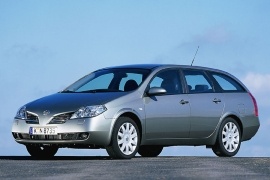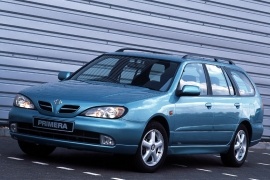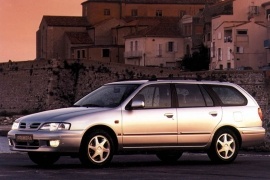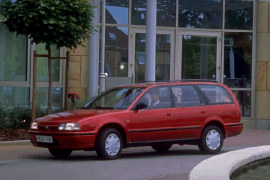NISSAN Primera Break Models/Series Timeline, Specifications & Photos
First production year: 1990
Engines: Gasoline, Diesel
Body style: Wagon (station wagon, estate, combi, touring)
After successfully introducing the third generation of the Primera in 2001, Nissan also completed the lineup in 2002 with the hatchback and the station wagon.
With more and more customers switching from minivans to station wagons, this market segment became more appealing to automakers. Nissan tried to provide them with a vehicle capable of moving not just five people in comfort but also with a trunk big enough to carry furniture. In addition, the car's high-tech features for those years and the innovative design should've made it a winner. Unfortunately, the car was too bold-looking, and many customers preferred something more conservative.
The third generation of the Primera, also known as the P12, featured a bold-looking front fascia. Its Flying-wing design of the grille was envisioned by the automaker ever since the nameplate's first generation in 1990, but on the P12, it was more pronounced. It was flanked by the big, rhomboidal, and swept-back headlights covered with clear lenses. On the lower side of the bumper, Nissan installed a second air intake to complement the cooling area.
From its profile, the 2002 Primera Wagon revealed a mixed styling between the bio-design and the new-edge theme. Its windshield was followed by a long roof that ended into a raked-forward, sporty-looking tailgate. It was also the first generation of this nameplate that sported body-colored grab handles for the doors. Depending on the trim level, the car rolled on steel or alloy wheels. As a result, the station wagon looked more conservative than the hatchback, and that's one of the reasons why it had a longer lifespan.
Inside, the bold interior provided ample room for five passengers. At the front, the mild-bolstered bucket seats were separated by a narrow center console where Nissan installed the handbrake, the gear stick, a pair of cup holders, and a storage compartment under the center armrest. But the most representative design theme was the dashboard. It featured a center-mounted instrument cluster filled with four main dials: the coolant temperature and the fuel level gauges, and two large dials for the speedometer and the tachometer. Lower, on the center stack, customers could get the car fitted with an infotainment system featuring an LCD that was used for the DVD-based navigation system, the rearview camera, the stereo, and the HVAC system. Behind, on the split-folding bench, the Primera P12 provided plenty of room for three passengers. Behind them, the trunk could hold up to 465 liters (16.4 cu-ft), but it could reach up to 1,670 liters (58.9 cu-ft) with the rear seats completely folded down.
Under the hood, the automaker offered the Primera with a choice of gasoline and turbo-diesel engines. The base models were paired with five-speed gearboxes, while the upper ones sent their torque to the front wheels via a six-speed transmission. As an option, depending on the grade and engine, the 2002 Primera Wagon was available with a CVT.
Just one year after the introduction of the Primera Wagon in 1998, Nissan refreshed the entire model’s lineup and that included the station wagon version as well.
While most European customers were satisfied with the Primera’s performance, reliability, and comfort, not all of them were pleased with the car’s styling. As a result, Nissan heavily invested in its design department, which came out with a refreshed version of the model in 1999 that was considered more acceptable. The automaker claimed that it upgraded or modified around 600 vehicle parts, and these changes were obvious. The car’s exterior and interior were closer to what other automakers offered, and the drivetrain was also improved. Still, the station wagon was not among the top sellers of the family, but it had to be upgraded along with the rest of the range.
With the 1999 model year, Primera followed the automaker’s design language named “Flying wing,” shown on the car’s grille. While some considered those elements like leaves, Nissan called them wings. The new headlights featured a curved upper line and sharp-angled inner section. On their upper outer sides, the automaker placed the turn signals. Lower, on the bumper, the automaker installed a second broad grille flanked by either triangular-shaped scoops or a set of fog lamps, depending on the trim level.
From its profile, the car’s look was similar to the rest of the range up to the B-pillar. The rear doors, on the other hand, were specific to the Break version. In addition, behind them, the automaker installed a set of windows next to the luggage area, while at the back, the car featured a slightly tilted forward tailgate. The rear fascia featured wide taillights with smoked lenses, making the car look sportier.
Inside, the automaker installed velour-covered front bucket seats divided by a narrow center console that housed the gear stick and the handbrake. The driver fronted a rounded instrument cluster where the speedometer took center stage and was flanked on its left by the tachometer and on the right by two smaller gauges for the fuel level and coolant temperature, respectively. In addition, Nissan added a small LCD for the odometer. The center stack housed the integrated stereo, which couldn’t be stolen anymore since it was encoded to the car’s ECU. To create an upscale feeling for the vehicle, the Primera Break sported soft plastic materials on the dashboard. Behind, the folding bench seat could accommodate three passengers. With the rear seats up, the trunk could hold up to 430 liters (15.2 cu-ft.), while with the seats folded, it provided 1,650 liters (58.3 cu-ft.) of space.
Under the hood, all engines complied with the Euro 3 emission standards. The most important novelty was the addition of a 1.8-liter gasoline engine. Nissan offered a choice of three gearboxes, depending on the powerplant version: a five-speed manual, a four-speed automatic, and a CVT.
Nissan didn’t intend to create a station wagon for the second generation of the Primera, but after it saw the high demand for such vehicles in Europe, it quickly adapted and introduced this type of bodywork for its mid-size contender in 1998.
While the sedan and the hatchback versions of the Primera were praised for their driving abilities, other automakers enjoyed their sales figures for their mid-size vehicles. Moreover, customers started to forget about MPVs and turned their attention to station wagons. These cars were more practical in terms of size and cheaper to buy and run. As a result, Nissan was caught off-guard, and since it didn’t have such a vehicle on offer, it had to create one as quickly as possible. Thankfully, it already had a trustworthy platform, so all it had to do was to create a new rear-end for the car. That took it some time and cost the automaker some sales. But eventually, it managed to launch the Primera Wagon in 1998.
Since Nissan introduced the second generation of the Primera in 1996, the automaker hasn’t considered introducing a facelift for it along with the station wagon version, even though the outdated front fascia design was obvious. The horizontal headlights resembled those from the cars penned in the mid-80s. Still, the lower side of the bumper looked more modern, especially when fitted with fog lamps.
From its profile up to the B-pillars, the Primera Wagon had the same body panels as its hatchback and sedan brothers. The rear doors, on the other hand, were reshaped, sporting different upper areas. Furthermore, behind the C-posts, the automaker installed a third row of windows next to the trunk space. Finally, at the back, the automaker placed a slightly tilted forward tailgate. Unlike the previous Primera generation, this one sported part of the taillights, making the car more visible. It is worth noting that Nissan assigned a different code for the vehicle. While the sedan and the hatchback versions were named P11, the Wagon was known as the WP11.
Inside, customers found a neatly designed dashboard that featured the instrument cluster’s visor extended above the center stack. At the front, the automaker installed a pair of bucket seats divided by a narrow center console that housed the gear stick and the handbrake. In the back, the automaker placed a split-folding bench seat that could host three adults. Thanks to the longer wheelbase than on its predecessor, the 1998 Primera Wagon offered more legroom for them. By folding down the rear seats, customers could expand the trunk space. Another unique feature of the vehicle was found in the trunk area, where the carmaker installed a clever system with a flip-over base that featured a plastic tray on one side and a flat, carpeted area on the other.
Under the hood, Nissan installed a choice of three engines paired with a five-speed manual gearbox. As an option, the two-liter version was available with a four-speed automatic as well.
Nissan introduced the first generation of the Primera in 1990 as a replacement for the aging Bluebird, offering it in three shapes: sedan, hatchback, and station wagon, the latter being named Traveller.
Since the Bluebird had a solid reputation as a dependable vehicle, customers received its successor with great enthusiasm. Unlike its predecessor, the first generation of the Primera was designed with the European customer in mind. With the Traveller, Nissan hit a soft spot for families looking for a vehicle large enough to carry them around with all the necessary luggage. Even though it was not a heartbreaker in terms of styling, its vast loading area made it a practical vehicle for families and small entrepreneurs who needed a car capable enough to carry their tools and materials but small enough to fit in tight parking lots.
At the beginning of the ‘90s, the design language started to shift from the wedged shapes of the early ‘80s to the bio-design era. As a result, the Primera’s front fascia featured a mix of both. Its rectangular, horizontal headlights featured shaved corners instead of sharp ones. Between them, the automaker installed a narrow grille that sported a wing design theme. Lower, on the bumper, the automaker added a second air intake that helped cool the engine. It was available with or without squared fog lights flanking it depending on the trim level and options.
The Primera Traveller was slightly taller than its brothers. Up to the B-pillars, it was similar to those, but the rear doors were different, featuring shorter windows and a less raked-forward cut. A set of roof rails was on the options list, depending on the grade. Behind them, the automaker installed a third set of wide windows that flanked the luggage compartment. At the same time, an almost vertical tailgate ended the car. The Primera P10 Traveller featured corner-mounted slim and tall taillights.
Inside, Nissan installed higher quality materials than those available for the Bluebird. The velour upholstery covered most areas, including the door cards, the transmission tunnel, and the seats. Fronting the driver was a new dashboard covered with soft plastics. The instrument cluster was extended above the center stack, which housed an off-the-shelf stereo and the HVAC control panel. Inside the instrument panel, customers could find large dials for the speedometer and tachometer and two gauges for the fuel level and coolant temperature. In the back, the folding bench could expand the storage area from a regular 460 liters (16.2 cu-ft.) to an impressive 1,700 liters (60 cu-ft.).
Under the hood, the automaker installed a range of gasoline and diesel engines with four cylinders. All of them were paired with five-speed manual transmissions, while a four-speed automatic was available for selected powerplants.



